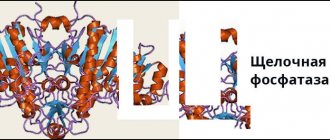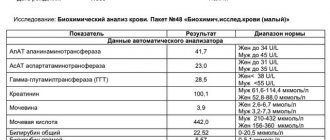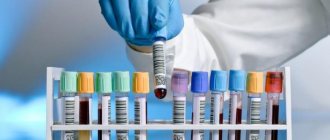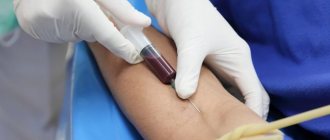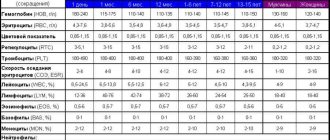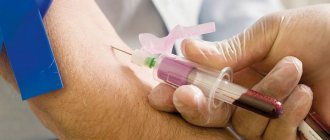Enzymes Indicators of lipid metabolism Indicators of protein metabolism Rheumatic tests Diagnostics of anemia Cardiac markers Indicators of residual nitrogen and purine metabolism Indicators of pigment metabolism Analysis for sugar Inorganic substances, macro and microelements Markers of osteoporosis
take a biochemical blood test for enzymes at the Health Laboratory CDC. We conduct research in a short time: in 2-3 days you can get the results. Thanks to the use of the latest equipment, we can guarantee the reliability of the results.
Biochemical blood test is one of the main methods of primary diagnosis of many diseases. It allows you to detect dysfunction of various organs and assess the deficiency of certain substances. The analysis determines the concentration and ratio of various enzymes. Depending on what disease the doctor suspects, a set of enzymes to be tested is selected. This profile is aimed at identifying pathologies of the liver, pancreas, and kidneys. Tests for these indicators can be taken at any office in our laboratory.
Before taking a biochemical blood test for enzymes, you must undergo preparation. The study is carried out strictly on an empty stomach, at least 8 hours must pass after the last meal. It is better to take tests in the morning, when enzyme levels are most objective. A few days before the procedure, you should avoid alcohol and fatty foods, high physical activity and severe stress. Following these measures will help you obtain the most reliable data possible.
A biochemical blood test for enzymes is highly informative. Based on the data obtained, the doctor can make a diagnosis, choose an appropriate treatment program or direction for further diagnostics.
Lipid metabolism indicators
Indications for laboratory testing of lipid metabolism are the diagnosis of the following diseases:
- atherosclerosis and its complications,
- IHD - coronary heart disease,
- myocardial infarction,
- stroke.
Increased concentrations of lipids in the blood significantly increase the risk of developing vascular complications in atherosclerosis. The level of substances largely depends on the quantities in which they are supplied with food. Therefore, to correct lipid status, a low-fat diet is often prescribed.
Analyzes allow you to determine the content of the main lipids - cholesterol and triglycerides. For transport in the blood, they bind to proteins - apoproteins. Such combinations are called lipoproteins. There are several types, differing in the level of triglycerides, cholesterol and apoproteins.
As part of a laboratory study of lipid metabolism, the concentration and ratio of all indicators of lipid status are determined:
- cholesterol,
- triglycerides,
- high and low density lipoproteins,
- apolipoproteins A1 and B.
A blood test is performed for diagnosis. Biomaterial is given on an empty stomach in the morning. Before the study, you must refrain from eating for 12 hours. In the morning you can only drink water. The blood collection procedure is painless and takes only a few minutes.
The study is carried out over 3 days. The results are available on our website after filling out a special form. You can also pick up the report in person or use a courier delivery service. The cost of the study is indicated on the website. Collection of biomaterial is paid separately.
Data decryption
Making a definitive diagnosis is not easy. Sometimes patients learn about rheumatoid arthritis 5-7 years later, when treatment is no longer effective and the disease has become chronic. Therefore, deciphering the blood tests obtained for arthritis requires accuracy, an understanding of the overall picture of the disease and the relationship of various data.
Rheumatoid arthritis and the degree of its development are characterized by the level of deviation of indicators from the norm. The greater the difference in indicators, the more severe the form of the disease. Clinical confirmation of any 4 markers in a patient over a period of 6 months is a medical examination of the diagnosis of rheumatoid arthritis.
Protein metabolism indicators
A biochemical blood test for protein includes the study of two main metabolic indicators:
- total protein,
- albumen.
The first allows you to evaluate the synthesis and breakdown of substances in the body as a whole. Its concentration may decrease due to:
- fasting,
- vegetarian diet,
- metabolic disorders,
- diseases of the digestive tract,
- neoplasms,
- significant blood loss,
- improper functioning of the liver and kidneys.
If a biochemical blood test shows a high concentration of total protein, this indicates:
- dehydration (for burns, gastrointestinal diseases),
- multiple myeloma.
Biopsy of the synovium of the joint
The rheumatoid type of arthritis is accompanied by inflammation of the synovial membrane of the joint. Research of materials in this area allows us to more accurately decipher the stages of the pathogenesis of the disease and develop more progressive treatment methods.
Immunohistochemical features of the synovium are excellent indicators of disease activity, and the use of biomarkers for laboratory purposes helps to identify new potentially effective agents in the fight against rheumatoid arthritis. An important quantitative indicator here is the content of macrophages in the subsynovial layer, which characterizes how treatable the disease is.
Bibliography:
- https://otnogi.ru/bolezn/artrit/pokazateli-krovi-pri-artrite-i-ix-normy-pri-analize.html
- https://revmatolog.net/diagnostika/analizy-na-revmatoidnyy-artrit
Analysis for protein fractions
Albumin is one of the fractions of total protein. A biochemical blood test for this indicator is prescribed if kidney and liver pathology is suspected. The reasons for the increase and decrease in concentration are the same as for the main substance. Albumin levels may also be reduced in pregnant or breastfeeding women or young children.
To determine the level of other specific proteins, you need to take blood tests to compile a proteinogram. The biochemical test allows you to evaluate the concentration of alpha, beta and gamma globulin fractions, as well as their qualitative composition. The level of these substances in the blood increases significantly during inflammatory processes or exacerbations of chronic diseases. Malignant tumors also cause an increase in their plasma volume.
A biochemical blood test for total protein and its fractions is taken strictly on an empty stomach. The day before the test, it is necessary to exclude fatty and heavy foods from the diet. Compliance with these requirements guarantees the accuracy and information content of the test.
Erythrocyte sedimentation rate
Erythrocyte sedimentation is studied in vitro over a certain period of time. The indicator characterizes the intensity of the development of pathology, the activity of the spread of destructive processes. High ESR values indicate progression of the disease and the need for effective medication measures. Moreover, the higher the settling rate, the more active the phase. This process is explained by the formation of inflammatory proteins in the patient’s blood, which cause the formation of red blood cells into aggregates, an increase in gravity and the rate of their sedimentation.
Erythrocyte sedimentation rate indicates an inflammatory process in the body
Rheumatic tests
A blood test for rheumatic tests is usually performed as part of a comprehensive examination of the immune system.
During the tests, the amount of specific proteins that are markers of systemic or autoimmune diseases is determined. Rheumatic tests include blood tests to determine the following protein compounds:
- C-reactive protein,
- rheumatoid factor,
- ASL-O.
The level of C-reactive protein increases if there is an inflammatory process in the body. This test is carried out in cases of suspected chronic infectious diseases with a latent course. Taking a blood test is not recommended for people who have recently undergone surgery or been injured, as protein levels also increase when tissue is damaged.
A blood test for rheumatoid factor is prescribed for the differential diagnosis of rheumatoid arthritis. During the rheumatic test, the quantitative content of protein compounds in the serum is determined. A significant excess of the norm indicates a severe course of arthritis. High rheumatic test scores can also be a sign of connective tissue inflammation or viral infections.
Antistreptolysin-O is a marker of streptococcal infections. This protein is found in the blood of patients with meningitis, scarlet fever, and myocarditis. Streptococcus also leads to exacerbation of rheumatoid arthritis, so patients with this diagnosis should undergo this test regularly.
All blood tests for rheumatic tests are taken strictly on an empty stomach, after 8-12 hours of fasting. A few days before the test, you need to stop taking medications, give up alcohol and significant physical activity. The test will not be informative if you donate blood after an X-ray examination.
Circulating immune complexes
These indicators make it possible to determine the immunological activity of the current acute, chronic disease.
If the biological fluid shows an excess of proteins that perform the functions of antigens, antibodies lose the ability to neutralize them. As a result, immune complexes are formed in the blood, deposited on the walls of blood vessels, the surfaces of the joint membranes, and in other organs. The result of the pathological process is the development of reactive inflammatory processes of the knee joint and others.
- Examinations necessary for differential diagnosis between arthritis and arthrosis
Immune complexes circulating freely in plasma are in direct contact with red blood cells. They do not have a damaging effect on organs. The concentration of free CECs in the blood is gaining increasing diagnostic importance.
A direct relationship between the development of the pathological process of the knee joint has been identified in cases of systemic lupus erythematosus.
The indicator is taken into account in the diagnosis of rheumatological diseases. The level directly affects the clinical picture and the prescribed treatment.
The high concentration of circulating immune complexes in the serum of patients suffering from rheumatoid arthritis indicates the systemic nature of the pathological process and requires additional research.
When laboratory diagnostics of immunoglobulins and circulating immune complexes are carried out, it is worth taking into account an increase in content of at least 2-3 times. In a healthy person, circulating immune complexes are not detected.
Foot treatment
Diagnosis of anemia
CDC "Health Laboratory" diagnoses anemia using blood tests. On this page you will find a set of studies that you can take separately or together.
Anemia, or anemia, is a group of syndromes that have a common symptom: a decrease in the level of hemoglobin in the blood, usually with a simultaneous decrease in the number of red blood cells. Assessing the following indicators increases the accuracy of diagnosing anemia using blood tests:
- LVSS - ability of serum to bind iron; one of the main indicators used to diagnose anemia using a blood test ; changes with disturbances in microelement metabolism; in the case of iron deficiency anemia, the LVSS increases; if complex tests show a low level of serum iron, this indicates anemia, which is associated with chronic diseases, cancer, infections,
- vitamin B12 - important for the normal formation and maturation of red blood cells; The risk of cyanocobalamin deficiency is highest in vegetarians, since the vitamin comes with animal products, a decrease in concentration affects the decrease in the amount of folic acid,
- B9 - folic acid is also important for hematopoiesis: it stimulates the formation of erythro-, leukocytes and platelets, the compound enters the blood along with green vegetables, wholemeal bread and is partially formed by intestinal microflora, the reserve of acid in the liver is small, a month of stopping consumption is enough for a deficiency to occur source products, anemia develops after four months.
As part of the diagnosis, you can take a blood test for transferrin, ferritin, and erythropoietin. Choose tests according to the recommendations of your doctor. Only a specialist evaluates the results obtained. Diagnosing anemia using a blood test can be difficult, so the doctor evaluates clinical symptoms, comprehensive research data, and medical history.
Changes in the blood with gouty arthritis
Characteristic of the pathology is damage to the small joints of the foot, less commonly the knee joint.
A characteristic sign of gouty inflammation is an increase in uric acid levels. Normally, in men the biochemical indicator does not exceed 460 µM/l, for women it is lower – 330 µM/l.
There is a category of healthy people whose plasma uric acid levels are elevated, but they do not suffer from gout. A number of cases of clinical manifestations of inflammation of the knee joint with normal laboratory parameters have been noted. It is worth additionally conducting a study of the amount of uric acid in daily urine.
Biochemical indicators for gout are determined by an increase in the following components:
- Haptoglobin is a protein whose main purpose is to bind free hemoglobin. In a healthy person, the concentration does not go beyond 450 – 1600 mg per 1 liter of blood
- Seromucoid is a complex fraction of plasma proteins that have carbohydrate chains in their chemical composition. The norm for this indicator should not exceed 1.6 mmol per liter.
With gouty inflammation, a general nonspecific indicator is determined - an increase in ESR, a change in the amount of fibrin.
Rheumatoid arthritis is a difficult disease to diagnose, and as part of its diagnosis, many tests are prescribed to determine the form of the disease. The article describes in detail all the most effective tests.
Cardiac markers
Cardiac markers are specific protein compounds found in muscle tissue. In heart disease, cells are damaged and released enzymes enter the blood. A large number of amino acids in the blood may also indicate the destruction of skeletal muscles and hidden bleeding.
Tests for cardiac markers are prescribed:
- in preparation for surgery under general anesthesia,
- patients with complaints of heart pain,
- for differential diagnosis of cardiovascular diseases.
Patients admitted with suspected heart attack are tested for myoglobin, troponin I and creatine kinase. An increase in the concentration of these proteins in the blood begins within a few hours after damage to the heart muscle.
If systemic heart disease or destruction of the vascular wall is suspected, a blood test is performed for the cardiac marker homocysteine. An increase in amino acid concentration indicates damage to the vascular epithelium. Indicators below normal are a sign of a lack of folic acid and B vitamins in the body.
Patients with ischemia or acute coronary syndrome should be regularly tested for troponin I. This specific protein is present only in the heart muscle and is released when its cells are damaged at the slightest level. An increase in the concentration of a cardiac marker indicates the risk of developing myocardial infarction in the near future.
You can undergo any test in our laboratory without a doctor’s prescription. All you need to do is make an appointment by phone. Test results for cardiac markers will be ready in one to five business days, depending on the number of indicators. You can obtain the data at the office where the survey was conducted or by email.
Result
The norm for biochemical analysis of residual nitrogen is from 14.3 to 28.6 mmol/l.
An increase in residual nitrogen may indicate:
- acute or chronic renal failure;
- renal dysfunction;
- heart failure;
- dehydration;
- obstruction of the urinary tract;
- bleeding from the upper digestive tract;
- severe bacterial infections;
- decreased adrenal function (Addison's disease).
A decrease in residual nitrogen levels may be a symptom of:
- liver failure;
- viral, toxic and autoimmune hepatitis;
- celiac disease.
Antinuclear antibodies
This serological indicator is often determined in the laboratory diagnosis of rheumatological diseases of the joints, especially the knee. Relevant for initial diagnosis. The diagnostic method is indispensable as a screening method to exclude systemic connective tissue diseases with predominant damage to the joints.
When conducting the study, the technique of indirect immunofluorescence is used. The intensity of staining of cell nuclei is assessed.
The method detects the presence of immunoglobulins of various classes; the method is sensitive to immunoglobulins of classes G. Antibodies belonging to group A, M are determined by the method more difficult. The analysis of antinuclear antibodies is considered reliable at a dilution of 1 to 20; lower dilutions indicate a false positive reaction.
Biochemical analysis for antinuclear antibodies is not specific for joint diseases; it should be used in combination; laboratory and instrumental studies are prescribed.
Staining of nuclei with fluorescent dye can be of four main types.
- Diffuse, homogeneous type. The entire cell nucleus glows.
- Staining in the form of individual spots is due to the presence of specific groups of antibodies.
- Peripheral staining in the form of a bright luminous rim surrounding the outer part of the nuclear structure. Coloring is caused by antibodies in DNA consisting of two chains.
- Luminescence of nucleoli. Staining in joint diseases is rare.
Preparation
A biochemical blood test requires special preparation.
- You need to take the test strictly on an empty stomach, after 8-12 hours of fasting, you can only drink still water.
- You should not change your diet for 3 days, but try to exclude fatty, spicy and fried foods.
- It is recommended to stop playing sports 3 days before the test.
- You should take a biochemical test in the morning, from 7 to 11 am.
- You should stop taking medications 3 days in advance; if this is not possible, notify your doctor.
- It is advisable to take tests in the same laboratory
Pigment metabolism indicators
A biochemical test for bilirubin allows you to determine the condition of the liver and biliary tract. It is carried out according to the following indications:
- liver diseases,
- cholestasis,
- hemolytic anemia,
- diagnosis of jaundice of various origins.
As part of a biochemical blood test, two indicators are assessed.
- Direct bilirubin is synthesized from free bilirubin due to binding with glucoronic acid. By its concentration one can judge the condition of the biliary tract and liver and identify the causes of jaundice. The enzyme content increases when there is a violation of the outflow of bile, hepatitis and other pathologies. A significant release of bilirubin into the blood causes yellowing of the skin and sclera of the eyes, and darkening of the urine.
- Total bilirubin is a breakdown product of myoglobin, hemoglobin and cytochromes. It is formed in the cells of the liver and spleen and is one of the main components of bile.
There is a normal value for bilirubin content: indirect - up to 17.1 µmol/l, direct - up to 4.3 µmol/l. Exceeding the concentration may indicate the following violations:
- vitamin B12 deficiency,
- liver cancer,
- hepatitis, primary cirrhosis,
- formation of gallstones,
- Gilbert's disease
- poisoning - medicinal, alcoholic or toxic.
To make an accurate diagnosis, additional tests are prescribed.
Before taking a bilirubin test, you should undergo simple preparation. The procedure is carried out strictly on an empty stomach, at least 8 hours must pass after the last meal. The day before, give up alcohol and fatty foods, reduce physical activity and try to avoid stress. Following these recommendations allows you to obtain the most reliable data.
About laboratory diagnostics and tests
To identify the rheumatoid type of arthritis, specific and nonspecific tests are taken:
- Specific - provide unambiguous confirmation or refute the fact of the disease with high reliability.
- Nonspecific - they work only in combination with other survey data, since they reveal only individual signs.
Tests are carried out of a specific and non-specific nature.
The attending physician must determine which tests need to be taken for rheumatoid arthritis. The patient’s examination plan includes undergoing a comprehensive diagnostic set of measures:
- blood biochemistry, its clinical examination, determination of ACCP (anti-citrullinated bodies), immunological analysis;
- general urine analysis;
- intra-articular fluid analysis;
- biopsy of the joint membrane.
You may need to submit your urine for analysis.
Specific indicators can reveal rheumatoid arthritis even before the first signs of the disease appear. Patients with a hereditary predisposition can use this method to prevent the disease and its transition to the chronic stage.
Rules for taking tests
Establishing an accurate diagnosis for rheumatoid arthritis of the joints is based on competent interpretation of clinical results and professional ability to interpret them in a complex manner. To obtain reliable results, special preparation is required before donating blood. A referral for laboratory tests must be issued by one of the treating specialists: a general practitioner, rheumatologist, surgeon or immunologist. To fully study the indicators, you need to donate blood from a vein, observing the following conditions:
- Do not eat food 12 hours before taking the test (for children under one year old - half an hour, from 1 to 5 years - 3 hours).
- Do not drink alcoholic beverages during the day.
- Stop taking medications the day before with your doctor's permission.
- Avoid physical activity and nervous stress an hour before the test.
- Do not smoke for at least 30 minutes before the test.
It is necessary to properly prepare for the tests.
Diet violations, use of medications or smoking distort the clinical data of blood composition and mislead when interpreting the results.
Sugar analysis
The laboratory of the CDC "Health Laboratory" offers
a blood test for sugar The main tests are collected in a special profile. You can choose individual tests or undergo a comprehensive study. Doctors recommend taking a blood and urine test for sugar in the following cases:
- diagnosis and control of diabetes mellitus types I and II,
- pathologies of the thyroid gland, pituitary gland, adrenal glands,
- liver diseases,
- determination of tolerance to glucose (a component of sugar) when testing patients at risk,
- obesity,
- diabetes during pregnancy.
A blood test for glucose concentration is the main test for diagnosing diabetes mellitus. This is what you should take first when the following symptoms appear:
- excessive urination due to an increase in the osmotic pressure of urine caused by glucose dissolved in it (in a healthy person, the analysis shows the absence or minimal level of this substance),
- constant thirst associated with fluid loss,
- unexplained hunger and weight loss due to metabolic disorders.
These symptoms develop acutely and are most typical of type I diabetes. Secondary signs:
- itching,
- dry mouth,
- muscle weakness,
- skin inflammation,
- visual impairment.
A blood test for glycated hemoglobin is indicated for long-term follow-up of patients to monitor treatment and the degree of compensation. The level of this substance reflects hyperglycemia - an increase in sugar, typical of diabetics.
An endocrinologist will explain to you the expediency of the research. If your doctor has prescribed tests for sugar and other substances to assess carbohydrate metabolism, we invite you to undergo a comprehensive diagnosis with us. We use modern equipment to obtain accurate results.
Rheumatoid factor
This laboratory indicator helps determine the presence in the plasma of protein formations synthesized by the body. These proteins act as antibodies. Rheumatoid factor is an immunoglobulin produced by the immune system that attacks the body's own tissues.
Infection with beta-hemolytic streptococcus often leads to the development of the process. Rheumatoid factor determines what autoimmune processes occur in the body.
In a healthy person, the normal rheumatoid factor ranges from 0 to 14 IU per ml. An increase in the level of rheumatoid factor in the blood indicates the presence of chlamydial infection and the presence of other infections that are predominantly sexually transmitted.
Rheumatoid factor is not always detected in joint diseases. Diagnostics should take into account laboratory data, the clinical picture, and the results of instrumental examinations. Synovial fluid may contain rheumatoid factor.
Determination of protein formations
Inorganic substances, macro and microelements
A biochemical blood test for trace elements is a study that allows you to comprehensively assess the condition of the body, the functionality of systems and organs, identify symptoms of diseases or determine which vitamins and minerals a person lacks.
Most often, biochemical tests are taken to determine the content of vital (essential) elements in the blood:
- calcium;
- potassium;
- sodium;
- chlorine;
- magnesium;
- phosphorus;
- copper;
- gland;
- zinc
A blood test for microelements allows you to:
- reflect the functional state of organs and systems;
- identify an active inflammatory process;
- establish the fact of a violation of water-salt metabolism;
- identify rheumatic processes;
- correctly diagnose and prescribe effective treatment that will be effective;
- prevent the development of diseases.
Knowing the microelement profile of the body is important for the correct prescription of vitamin-mineral complexes, since some initially beneficial microelements in high concentrations become hazardous to health. An imbalance of vitamins and minerals can lead to:
- decreased immunity;
- diseases of the skin, hair, nails;
- allergies, bronchial asthma;
- diabetes, obesity;
- hypertension;
- diseases of the cardiovascular system;
- scoliosis, osteoporosis, osteochondrosis;
- blood diseases;
- intestinal dysbiosis, chronic gastritis, colitis;
- infertility, decreased potency in men;
- delayed mental and physical development.
You can take a biochemical blood test for microelements at any of our laboratory offices. The study should be carried out on an empty stomach; it is recommended to stop taking medications 3 days before. You can get additional information by phone.
Markers of osteoporosis
Laboratory diagnosis of osteoporosis includes tests for the following indicators:
- calcitocin is a hormone that maintains a constant level of calcium in bone tissue, preventing its destruction,
- parathyroid hormone - indicates the effectiveness of calcium metabolism, controls the flow of calcium and phosphate from the bones into the blood,
- Deoxypyridinoline (DPID) is the most specific marker of bone destruction; is the main material of collagen cross-links,
- Osteocalcin is a key non-collagenous bone protein; its content reflects the metabolic activity of osteoblasts,
- b-Cross Laps is a degradation product of type 1 collagen; an increase in its concentration indicates an acceleration of the process of collagen destruction.
A blood test is performed to diagnose osteoporosis. A comprehensive assessment of several indicators allows you to accurately diagnose and identify the causes of osteoporosis.
The disease is characterized by a violation of the structure of bone tissue, a decrease in bone mass. Accompanied by an increase in the activity of osteoclasts - cells that destroy bones. Osteoblasts - creating cells - do not fill the resulting cavities, as a result of which the tissue is not restored. Several functional techniques are used for diagnosis:
- bone densitometry,
- radioisotope bone scan,
- trepanobiopsy.
Laboratory diagnostics is the final stage of examination. It allows you to confirm the doctor’s assumptions and identify the conditions for the course of the disease.
You can get tested at any office of the Health Laboratory CDC. It takes about 7 days to diagnose osteoporosis. We will inform you additionally when the results are ready.
What is rheumatoid arthritis?
Rheumatoid arthritis is a disease whose symptoms can be misleading for a long time. The disease has already been discussed in detail in this article. The autoimmune nature of the disease provokes damage to more and more areas of joint mechanisms, tissues and organs. Thus, a patient in the initial stage of the disease encounters the following symptoms:
- Discomfortable sensations in the joints, including during palpation.
- Difficulty in mobility after staying in one position for a long time.
- The appearance of subcutaneous lumps.
- Swelling and redness of the articular phalanges of the hands.
- Observation of the symmetrical development of inflammation in the small joints of the hands and feet.
- Fatigue, apathy, weight loss.
Rheumatoid arthritis is a pathology that is accompanied by discomfort in the joints.
The course of the disease consists of a gradual change in the protein structure under the influence of pathogenic factors. This leads to the formation of autoimmune antibodies that kill healthy cells and destroy the synovium of the joint. Ultimately, excessive proliferation of synoviocytes occurs, cartilage and bone tissues are affected, and the joint undergoes deformation.
To accurately diagnose the disease, it is necessary to conduct differential studies of the patient’s biological materials. There are laboratory and instrumental methods for identifying disease factors.
